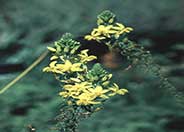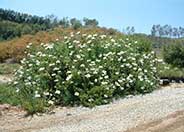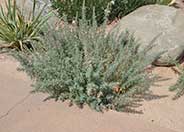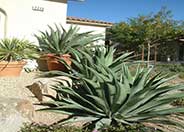
Common name:Yellow bulbine
Botanical name:Bulbine frutescens 'Yellow'
This clumping groundcover grows 1' tall and 1'-3' wide. It produces 12"-18" flower stalks that bear clusters of small yellow flowers almost all year. Succulent evergreen leaves are fragile, so locate away from foot traffic. Growth habit is not very tidy whereas the orange cultivar 'Hallmark' is a bit more so. This So. African native blooms most heavily in spring and fall with sporadic spikes in summer. It is also a good container plant and for erosion control.

Common name:Matilija Poppy
Botanical name:Romneya coulteri
Crowned by white poppies, this high-impact, spreading, gray green perennial stands statuesque at 8' tall. It is best used where its scale and habit will not overpower neighboring plants. It requires no summer water and thrives on dry alluvial slopes.
Maintenance Tips
Romneya coulteri is a large, herbaceous, California native perennial that is grown for its attractive gray-green foliage and showy, white poppy flowers that bear resemblance to fried eggs. It can grow up to about 8' tall and wide but can spread up to 20’ away by underground runners known as rhizomes. Despite its large size, it is relatively easy to maintain. Flowering begins in the spring and lasts until late summer. In the fall, the foliage will start to wither, which is when it is best to cut all the stalks down to about 6". Once they are removed, you can leave this plant alone to regrow back in a matter of a couple of months.
Common name:Purple Leaf Eastern Redbud
Botanical name:Cercis canadensis 'Forest Pansy'
This small tree may reach 25' tall and it has dark green/purple leaves that are purple in the fall. Amazing pink flowers bloom in the spring and fill the tree.

Common name:California Fuchsia, Zauschneria
Botanical name:Epilobium canum
The California fuchsia is a perennial with dense, narrow, green gray foliage and red orange summer flowers. The growth habit of this plant is sprawling and low. The California fuchsia is native to California, is drought tolerant, and attracts hummingbirds.

Common name:Catmint
Botanical name:Nepeta X faassenii
Nepeta faassenii makes soft, gray green, undulating mounds that are 1.5' high when blooming. The small leaves are attractive to cats. This perennial has lavender blue flowers in late spring and early summer.

Common name:Damianita
Botanical name:Chrysactinia mexicana
This mounding groundcover grows slowly to 2' tall and wide. Golden yellow daisylike flowers appear in spring and fall. The yellow flowers agains the aromatic dark green foliage makes it a colorful accent. Good for courtyards. Resembles turpentine bush but has longer bloom period. Needs good drainage. Periodic pruning willinduce flowering. Accepts reflected sun. It is a slow grower so be patient. Native to western Texas and Mexico.
Maintenance Tips
Chrysactinia mexicana is a small, evergreen perennial with fragrant foliage and very showy flowers that emerge in spring. This is a very drought-tolerant plant that will look and perform its best in full sun and well-drained soil. It is considered pest and disease-free and gets all of the nutrients it needs in just about any soil condition. It only grows 1-2' tall and wide, so it can be used in just about any space in any sized garden without having to prune to maintain the size. After the blooming ends, the plant will benefit from some pruning to cut off the spent flowers and to improve the shape. If the blooms start to slow down in the summer, this plant will benefit from some supplemental water. The additional water can keep the plant blooming until the fall.
Common name:Damianita
Botanical name:Chrysactinia mexicana
This mounding groundcover grows slowly to 2' tall and wide. Golden yellow daisylike flowers appear in spring and fall. The yellow flowers agains the aromatic dark green foliage makes it a colorful accent. Good for courtyards. Resembles turpentine bush but has longer bloom period. Needs good drainage. Periodic pruning willinduce flowering. Accepts reflected sun. It is a slow grower so be patient. Native to western Texas and Mexico.
Maintenance Tips
Chrysactinia mexicana is a small, evergreen perennial with fragrant foliage and very showy flowers that emerge in spring. This is a very drought-tolerant plant that will look and perform its best in full sun and well-drained soil. It is considered pest and disease-free and gets all of the nutrients it needs in just about any soil condition. It only grows 1-2' tall and wide, so it can be used in just about any space in any sized garden without having to prune to maintain the size. After the blooming ends, the plant will benefit from some pruning to cut off the spent flowers and to improve the shape. If the blooms start to slow down in the summer, this plant will benefit from some supplemental water. The additional water can keep the plant blooming until the fall.
Common name:Damianita
Botanical name:Chrysactinia mexicana
This mounding groundcover grows slowly to 2' tall and wide. Golden yellow daisylike flowers appear in spring and fall. The yellow flowers agains the aromatic dark green foliage makes it a colorful accent. Good for courtyards. Resembles turpentine bush but has longer bloom period. Needs good drainage. Periodic pruning willinduce flowering. Accepts reflected sun. It is a slow grower so be patient. Native to western Texas and Mexico.
Maintenance Tips
Chrysactinia mexicana is a small, evergreen perennial with fragrant foliage and very showy flowers that emerge in spring. This is a very drought-tolerant plant that will look and perform its best in full sun and well-drained soil. It is considered pest and disease-free and gets all of the nutrients it needs in just about any soil condition. It only grows 1-2' tall and wide, so it can be used in just about any space in any sized garden without having to prune to maintain the size. After the blooming ends, the plant will benefit from some pruning to cut off the spent flowers and to improve the shape. If the blooms start to slow down in the summer, this plant will benefit from some supplemental water. The additional water can keep the plant blooming until the fall.
Common name:Smooth-edged Agave
Botanical name:Agave weberi
This is a striking medium-sized Agave that can grow to 5' tall by 6'-10' wide. This agave has very fine marginal teeth and is sometimes spineless. Supplemental summer watering can prevent yellowing from heat stress in the summer. These plants are also moderately cold hardy and tolerant of temperatures down to 12 degrees F. It is more refined looking than americana. It is native in central Eastern Mexico. It is one of the largest of the Agaves.

Common name:Sundrops
Botanical name:Calylophus hartwegii
This low-growing perennial grows 1' tall and 3' tall; it has woody stems with bright green leaves. It produces large, lemon yellow flowers that are up to 4" across and bloom spring through summer and possibly through fall, depending on weather conditions.
Maintenance Tips
Calylophus hartwegii is a soft-textured, low-growing perennial with bright yellow flowers. It only grows 12" tall and up to 3' wide. It is very fast growing in the late winter and early spring, and then it is covered with flowers from mid-spring until fall if the weather is ideal. In the fall, when the days start to get shorter and the rains begin, this plant can decline. The root system will stay intact, but the flowering stops, and the foliage will completely die back. This plant benefits from hard pruning, taking the foliage, and branching almost down to the ground. Don't expect any new growth to emerge until the days start to get longer and warm up. The foliage will start to emerge, and the plant's quick growth and blooming cycle will return.Designer: Susan Triindle
Photographer: GardenSoft